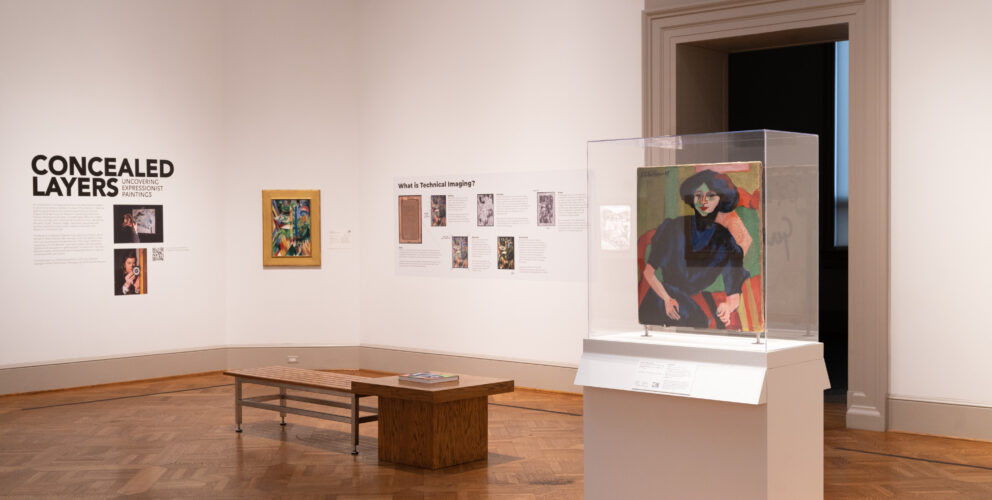Ernst Ludwig Kirchner, German (active Switzerland), 1880–1938; Circus Rider (detail), 1914; oil on canvas; 79 x 59 7/16 inches; Saint Louis Art Museum, Bequest of Morton D. May 904:1983
Ernst Ludwig Kirchner’s Circus Rider has been a staple in SLAM’s German Expressionism collection since the work was gifted by Morton D. May in 1983. In the painting, the red circus ring and green and yellow lights flip upright to form a halolike background, which makes the horse and rider that fill most of the canvas appear frozen in profile. The massive six-and-a-half-foot abstract work is one of many circus-themed, big-city paintings Kirchner did during his time in Berlin before the outbreak of World War I.
In a 2024 catalogue of the Museum’s German Expressionist paintings, curator Melissa Venator argues there could be a connection between the horse rider seen in many of Kirchner’s circus works and that of a mounted artillery soldier, a role Kirchner attempted but never achieved.

Ernst Ludwig Kirchner, German (active Switzerland), 1880–1938; Circus Rider, 1914; oil on canvas; 79 x 59 7/16 inches; Saint Louis Art Museum, Bequest of Morton D. May 904:1983
Circus Rider was painted in 1914; exactly when is unknown. After months of escalating tensions, by August of that year the war broke out, and Kirchner had to weigh his options: Wait to be drafted to the infantry where he’d likely be forced into strenuous labor, like digging trenches, or volunteer for a more prestigious branch of the military? In the spring of 1915, he enlisted in the artillery, the chief appeal of which was horseback riding. However, his service was short-lived. The physical exertion and discipline were too much for the artist, and he deliberately abused drugs and alcohol to secure a medical discharge. The strategy worked, but it also left him with a crippling drug addiction compounded by his feelings of shame for his failure.
“I have always the impression of a bloody carnival. How will it end?” Kirchner wrote about the war a few weeks prior to a 1916 acute mental health crisis, as cited in the Museum’s German Expressionism catalogue. The bloodred ring in Circus Rider, which had been on view that year in an exhibition, may have been on his mind, SLAM catalogue author Venator suggests.
If the horse and rider in the painting are related to that of artillery soldiers, then the nature of that relationship remains an open question. Two Kirchner works made in 1915, a lithograph and a related sculpture, depict mounted soldiers, with the horses appearing in the same rearing stance as that in SLAM’s painting. Venator contends it is possible Circus Rider was painted in late 1914, after the start of the war, when the artist was faced with the inevitability of military conscription and pressure to decide his future.

Ernst Ludwig Kirchner, German (active Switzerland), 1880–1938; Rearing Horse with Rider (Steigendes Pferd mit Reiter), 1915; lithograph; 23 3/8 x 19 13/16 inches; Städel Museum, Frankfurt am Main, Germany
“Perhaps Circus Rider is an erstwhile self-portrait, in which Kirchner cast himself as both a death-defying circus performer and future mounted officer: a masterful rider in effortless control of his rearing steed. If so, it was a high standard that Kirchner failed to achieve,” Venator writes. “His esteem of the artillery soldier, personified in the tuxedoed circus rider, might also explain the depth of the depression that followed his discharge.”
Did you know?
On the reverse side of the canvas from Circus Rider is an entirely separate painting, Dancers with Castanets.

Ernst Ludwig Kirchner, German (active Switzerland), 1880–1938; Dancers with Castanets (verso), 1910; oil on canvas; 79 x 59 7/16 inches; Saint Louis Art Museum, Bequest of Morton D. May 904:1983
The painting depicts a man and woman in folk costumes playing castanets and dancing on a stage. Kirchner made the work in 1910 of an actual performance he attended at Dresden’s Central Theatre by “La Tortajada,” a Spanish vaudeville artist. He later described the performance to German painter Erich Heckel in a letter, which also included a sketch of the performance in the same pose and with the same costumes.
Though he decided to reuse the canvas four years later, Kirchner thought enough of Dancers with Castanets to include it in a 1910 exhibition in Dresden. It wasn’t, however, among his works listed in the exhibition’s catalogue, but a photograph of the installation was taken.

Dancers with Castanets (right) installed at the Galerie Arnold, Dresden, 1910. Photograph by Ernst Ludwig Kirchner, Kirchner Museum Davos, Switzerland.
Dancers with Castanets was covered by an adhesive-coated canvas, called a lining, in order to repair a large tear in 1979. X-rays confirm the presence of the painting on the reverse of Circus Rider, but it cannot be safely uncovered at this time. Museum conservators hope to pursue further research to see if the covered painting could be revealed. For now, a full-size blowup image of Dancers with Castanets is on view alongside Circus Rider in a SLAM exhibition, Concealed Layers: Uncovering Expressionist Paintings.
The exhibition, which features 11 paintings along with conservation images and examples of the tools and materials used during research, presents new discoveries made during a three-year study of the Museum’s collection of German Expressionist works for the catalogue. Complete underpaintings, a lost title, and studio graffiti are just some of the exciting findings that received their public debut. Concealed Layers was curated by Courtney Books, associate paintings conservator, and Melissa Venator, the Andrew W. Mellon Foundation Assistant Curator of Modern Art. It is on view through October 17.
This information was adapted from an essay in German Expressionism: Paintings at the Saint Louis Art Museum, written by Melissa Venator, the Andrew W. Mellon Foundation Assistant Curator of Modern Art. The book examines 48 works that were made from 1905 to 1939 by more than two dozen artists. It is available for purchase online and in Museum shops.

